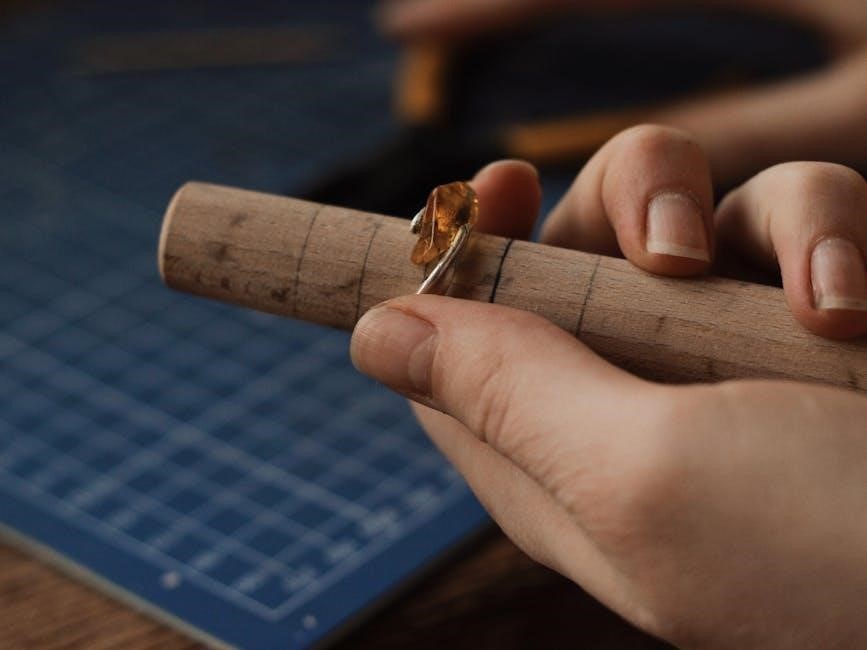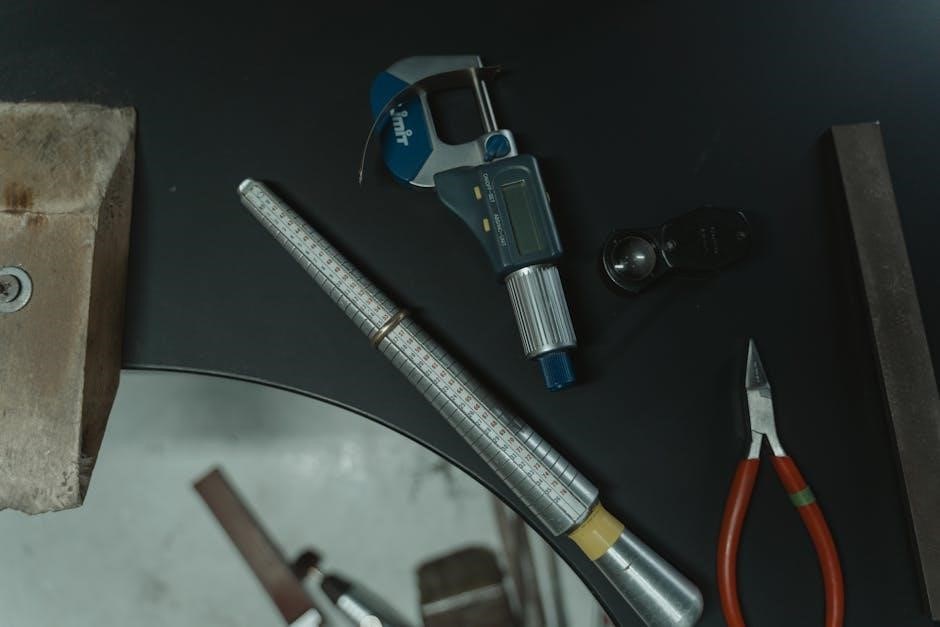Understanding your ring size is essential for both comfort and style. This guide helps you navigate measuring methods, size charts, and factors affecting your perfect fit.
Importance of Knowing Your Ring Size
Knowing your ring size ensures a perfect fit, blending comfort and style seamlessly. A well-fitting ring avoids discomfort and the hassle of resizing or returns. Proper sizing ensures the ring stays securely in place without being overly tight, enhancing both aesthetics and functionality. Additionally, understanding your size helps when shopping online, where physical try-ons aren’t possible. It also allows for accurate comparisons across different sizing systems, such as US, European, or Asian standards. Measuring correctly accounts for factors like temperature fluctuations and knuckle size, ensuring the ring glides on easily and sits comfortably throughout the day. Accurate sizing is key to enjoying your jewelry to the fullest.
How Ring Sizes Are Measured
Ring sizes are measured based on the inner circumference or diameter of the band. The most common method involves determining the circumference in millimeters, which is then converted into standard size numbers or letters. For instance, a 50mm circumference corresponds to a specific size in different regions. Some jewelers use mandrels or ring gauges to measure existing rings, ensuring precision. Alternatively, a string or ruler can be used at home by wrapping it around the finger and measuring the length in centimeters or inches, which is then matched to a size chart. This ensures accuracy whether measuring at home or professionally, providing a reliable guide for the perfect fit.
Understanding Ring Size Charts
Ring size charts are standardized tools that help determine the correct fit based on measurements. They typically list sizes in numbers or letters, corresponding to specific circumferences in centimeters or inches. These charts vary by region, with the US, UK, Europe, and Asia each having their own systems. For example, a size 6 in the US is equivalent to an M in the UK and approximately 16.5mm in diameter. Understanding these charts is crucial for comparing sizes across regions and ensuring accuracy. They often include both circumference and diameter measurements, allowing consumers to match their finger measurements to the correct size. This guide is essential for jewelers and individuals alike to find the perfect fit.

How to Measure Your Ring Size at Home
Measuring your ring size at home is simple and accurate. Use a ring sizer tool, string, or ruler to find your size in centimeters or inches effectively.
Using a Ring Sizer Tool
A ring sizer tool is the most accurate method to determine your ring size. Simply place the tool over your finger, ensuring a comfortable fit without tightness or looseness. The tool measures the inside circumference of the band, providing a precise size in centimeters. This method is highly recommended for those unfamiliar with their size, as it eliminates guesswork and ensures a perfect fit. Always use a high-quality tool for the most accurate results, and refer to the included size chart to convert measurements to your desired regional standard, such as US, European, or UK sizes.
Measuring with a String or Ruler
To measure your ring size at home using a string or ruler, wrap a flexible string or a soft measuring tape around the base of your finger. Mark the point where the string overlaps, then lay it flat and measure the length in centimeters using a ruler. This measurement corresponds to the inside circumference of the ring. For accuracy, ensure the string fits comfortably without being too tight or loose. Compare your measurement to a standard ring size chart to determine your size in centimeters. This method is simple and effective, providing a reliable way to find your ring size without specialized tools. Always measure at room temperature for the best results.
Determining Size Based on Existing Rings
If you already own a well-fitting ring, you can use it to determine your size. Place the ring on a ruler or measuring tool and measure the inside diameter in centimeters. This diameter corresponds to your ring size. For accuracy, ensure the ring lies flat and the measurement is taken from one inner edge to the other. Compare this measurement to a standard ring size chart to find your size. This method is convenient and reliable, especially if you have a ring that fits comfortably. Always consider the thickness and design of the existing ring, as these can affect the fit. This approach avoids the need for new measurements and leverages what you already know fits well. It’s a practical solution for determining your ring size accurately.
Standard Ring Size Charts
Standard ring size charts vary by region, with measurements in CM. They provide a consistent reference for determining your ring size accurately across different countries and jewelers.
US Ring Size Chart in CM
The US ring size chart in centimeters is a standardized guide to help determine the perfect fit. It measures the inside diameter of the ring, which corresponds to specific sizes. For example, a size 4 ring has a diameter of 14.5mm, size 5 is 15.3mm, and size 6 is 16.1mm. This chart is widely used by jewelers to ensure accuracy. When purchasing a ring, it’s essential to consult this chart to match your finger measurements. It’s also helpful to get your size measured professionally, as sizes can vary slightly between manufacturers. Using this guide ensures comfort and proper fit, making it a reliable tool for choosing the right ring.
European Ring Size Chart in CM
The European ring size chart in centimeters provides a clear reference for determining ring sizes. It is based on the internal circumference of the ring, measured in millimeters. Sizes range from 40 to 70, with each size increasing by approximately 1.3mm. For instance, a size 48 ring has a circumference of 48mm, while a size 50 measures 50mm. This system is widely used across Europe and offers a precise method for jewelers and consumers alike. By measuring the finger’s circumference or using an existing ring, individuals can find their European size easily. This chart ensures an accurate and comfortable fit, making it a trusted resource for ring sizing.
UK Ring Size Chart in CM
The UK ring size chart in centimeters uses a letter-based system, ranging from A to Z. Each size corresponds to a specific measurement, increasing by approximately 1.1mm per size. For example, size H measures 46.8mm, while size L measures 51.9mm. This system is widely used in the UK and Ireland, offering a straightforward way to determine ring sizes. To find your size, measure the internal circumference of your finger or an existing ring. Converting sizes to US or European standards is also possible for international purchases. Accurate measurement ensures a comfortable fit, making this chart a reliable tool for selecting the perfect ring size.
Asian Ring Size Chart in CM
The Asian ring size chart in centimeters uses a numerical scale, typically ranging from 5 to 25. Each size represents the internal diameter of the ring in millimeters. For example, size 5 measures 15.7mm, while size 25 measures 50.3mm. This system is popular in countries like China, Japan, and South Korea. To determine your size, measure the inside of a well-fitting ring or use a string around your finger. The chart is designed to ensure a precise fit, accommodating the smaller average sizes common in Asian markets. Converting these sizes to US or European standards is also straightforward for international jewelry purchases, ensuring comfort and style.
Ring Size Conversion Guide
Convert ring sizes effortlessly between US, UK, European, and Asian standards using precise measurements in centimeters. This guide ensures accurate sizing for international jewelry purchases.
Converting US to European Sizes
Converting US to European ring sizes involves understanding the differences in their numerical systems. US sizes are based on the inside diameter of the ring, while European sizes use a continuous numbering system. To convert, subtract 2 from the US size to get the European equivalent. For example, a US size 6 is a European size 4. This ensures accurate sizing when purchasing jewelry internationally. Always refer to a size chart for precise conversions, as small discrepancies can affect comfort and fit. Accurate sizing is crucial for both style and comfort, making this conversion guide an essential tool for shoppers.
Converting UK to US Sizes
Converting UK to US ring sizes requires understanding their respective systems. UK sizes are typically letter-based, while US sizes are numerical. To convert, subtract 0.25 from the UK size to get the US equivalent. For example, a UK size L (5.75) corresponds to a US size 5.5. This slight difference ensures accurate sizing when purchasing jewelry across regions. Always use a size chart for precise conversions to avoid discomfort or poor fit. Proper sizing enhances both comfort and style, making this guide indispensable for international shoppers.
Converting Inches to CM for Ring Size
Converting inches to centimeters for ring size is straightforward. Since 1 inch equals 2.54 cm, multiply the inner diameter in inches by 2.54 to get the measurement in centimeters. For example, if a ring measures 0.7 inches inside, it converts to 1.778 cm. This conversion is essential for matching international size standards. When measuring with a ruler, ensure accuracy to avoid sizing errors. Always round to the nearest whole number for sizing charts. This method ensures a precise fit, whether purchasing domestically or internationally. Proper conversion enhances comfort and style, making it a vital step in choosing the right ring size.
Factors Affecting Ring Size
Ring size is influenced by temperature, knuckle size, and ring thickness. These elements impact comfort and fit, ensuring the ring sits perfectly without causing discomfort or restriction.
Temperature and Ring Fit
Temperature plays a crucial role in ring fit, as metal expands in heat and contracts in cold. This can cause a ring to feel looser in warmer conditions and tighter in cooler environments. For example, a ring measured in the morning may feel snug, while the same ring might feel restrictive by evening due to natural swelling of the finger. It’s important to consider temperature fluctuations when determining your size, as they can significantly affect comfort. Measuring at room temperature or avoiding extreme conditions ensures a more accurate fit. This natural expansion and contraction highlight the need for a balance between a comfortable and secure fit, regardless of environmental changes.
Ring Thickness and Comfort
Ring thickness significantly impacts comfort and fit. Thicker rings provide durability but can feel restrictive, especially on smaller fingers. Thinner rings offer a more delicate appearance and are often preferred for everyday wear. The thickness, measured in millimeters, affects how the ring sits on the finger. For instance, a 2mm band may feel comfortable for someone with slender fingers, while a 4mm band might be more suitable for larger hands. Balancing style and comfort is key, as a ring that’s too thick can cause discomfort, while one that’s too thin may bend easily. Choosing the right thickness ensures both aesthetics and practicality, enhancing overall satisfaction with the ring. Proper sizing accounts for this factor to guarantee a pleasant wearing experience.
Knuuckle Size and Ring Fit
Knuuckle size plays a crucial role in determining the perfect ring fit. A larger knuckle may require a slightly larger ring size to ensure comfort and easy removal. To measure knuckle size, wrap a string or ruler around the widest part of the knuckle and compare it to standard size charts. This ensures the ring slides on and off smoothly without being too tight or too loose. If the knuckle is significantly larger than the finger, it may be necessary to size up for comfort. Properly accounting for knuckle size ensures the ring remains secure yet comfortable, avoiding any potential discomfort or difficulty in removal. This factor is especially important for thicker rings, which may feel more restrictive if not sized correctly. Always consider knuckle size when choosing your ring to achieve the ideal balance between style and comfort.
Domed vs. Flat Rings
Domed and flat rings differ in design, which can impact fit and comfort. Domed rings feature a rounded, curved top, while flat rings have a sleek, low-profile design. The choice between the two often comes down to personal style, but it also affects how the ring sits on the finger. Domed rings may feel more spacious due to their shape, while flat rings provide a snug fit. When sizing, consider the thickness and height of the band, as these factors influence comfort and sizing accuracy. For example, a thicker domed ring might require a slightly larger size for comfort, whereas a flat ring may fit true to size. Ultimately, the ring’s design should align with your lifestyle and preferences to ensure the best fit;

How to Choose the Perfect Ring Size
Selecting the right ring size ensures comfort and style. Consider factors like finger shape, knuckle size, and ring thickness to find your ideal fit easily.
Signs of a Well-Fitting Ring
A well-fitting ring sits comfortably on your finger without slipping off or feeling too tight. It should rotate freely but not spin excessively. The ring should not pinch or restrict movement, allowing a slight gap between the band and your skin for comfort. Proper fit ensures the ring stays in place while performing daily activities. If the ring feels balanced and neither too loose nor too tight, it indicates an accurate size. Pay attention to these signs to ensure your ring is both stylish and comfortable for long-term wear.
When the Ring is Too Tight or Too Loose
If a ring feels too tight, it may cause discomfort or restrict blood flow, especially in warmer conditions. A ring that is too loose might slip off easily, increasing the risk of loss. Proper fit is crucial for both comfort and security. A tight ring should be avoided as it can lead to swelling or skin irritation, while a loose ring may catch on objects, causing damage. Ensuring the right balance prevents these issues, providing a comfortable and secure wear. Paying attention to how the ring feels and fits is essential for long-term satisfaction and safety.
Tips for Sizing Different Finger Shapes
Finger shapes vary, and sizing should be adjusted accordingly. For slender fingers, a slightly smaller size may be appropriate, while thicker fingers often require a larger size. Knuckle size is crucial—measure the widest part to ensure the ring can slide over comfortably. If fingers taper significantly, consider a ring with an adjustable band for a secure fit. For those with wider knuckles, opting for a ring with a comfort fit or curved design can enhance wearability. Consulting a professional jeweler is recommended for unique finger shapes to ensure the perfect fit and comfort.

Common Mistakes in Measuring Ring Size
Measuring at the wrong time, using incorrect tools, and not considering ring design are frequent errors. These mistakes can lead to an ill-fitting ring.
Measuring at the Wrong Time of Day
Measuring your ring size at the wrong time can lead to inaccurate results. For instance, your finger size may vary throughout the day due to factors like temperature and activity. In the morning, your fingers tend to be smaller due to lower blood flow, while they may swell slightly in the afternoon or evening. It’s recommended to measure your ring size at room temperature, avoiding times when your hands are cold or overly warm. Additionally, measuring after exercise or when your hands are swollen can also result in an incorrect size. Consistency is key for an accurate fit.
Not Considering the Ring’s Design
Ignoring the ring’s design when measuring can lead to a poor fit. For example, thicker bands may require a larger size for comfort, while narrower rings can fit more snugly. Additionally, rings with intricate details or settings may affect how they sit on the finger. The style of the ring, such as domed or flat, can also influence the fit; It’s crucial to consider these factors when choosing a size, as they can impact both comfort and appearance. Always ensure the size aligns with the specific design to avoid a ring that feels too tight or too loose. Proper fit ensures optimal comfort and style.
Using Incorrect Tools for Measurement
Using the wrong tools for measuring your ring size can lead to inaccurate results. For instance, using a standard ruler or household items without proper calibration may result in imprecise measurements. This can cause the ring to be either too tight or too loose, leading to discomfort or the need for resizing. It’s essential to use tools specifically designed for ring sizing, such as a ring sizer or a string method, to ensure accuracy. Incorrect tools often fail to account for the finger’s shape and knuckle size, which are critical factors in determining the right fit. Always opt for reliable methods to avoid sizing errors and ensure your ring feels comfortable and secure. Proper measurement tools are key to achieving the perfect fit.

How to Resize a Ring
Resizing a ring involves professional techniques to adjust the band’s fit. Jewelers use methods like stretching, soldering, or cutting to modify the size while preserving the ring’s integrity.
Professional Ring Resizing Options
Professional jewelers offer expert ring resizing services to ensure a precise fit. Techniques include soldering, stretching, or cutting the band, often involving resetting stones for stability. They use specialized tools to maintain the ring’s structural integrity while adjusting its size. This method is recommended for intricate designs or valuable pieces. Resizing typically takes a few days, depending on the complexity. Consulting a professional ensures the ring retains its value and aesthetic appeal. They also provide guidance on the best resizing method based on the ring’s material and design. This ensures a comfortable and durable fit without compromising the ring’s quality or appearance.
Adjusting Rings at Home Safely
Adjusting rings at home requires care to avoid damaging the piece. Simple tools like pliers or ring sizing kits can be used for minor adjustments. For prong-set stones, gently tighten or loosen the prongs. For bands, heating the metal slightly can make it more pliable. However, this method is risky and may weaken the metal. It’s crucial to follow detailed instructions or video guides. Avoid using harsh chemicals or excessive force. For intricate or valuable rings, professional resizing is recommended. Always prioritize caution to preserve the ring’s integrity and ensure a secure fit without causing irreversible damage.
Choosing the right ring size ensures comfort and style. Use this guide to measure accurately, consider factors like temperature, and opt for professional resizing if needed. Perfect fit guaranteed.
Final Tips for Choosing the Right Ring Size
To ensure the perfect fit, measure your ring size when your finger is at room temperature, as size can vary throughout the day. Consider the ring’s design and thickness, as wider bands may require a larger size. Use a ring size chart specific to your region, as sizing systems differ between countries. If unsure, consult a professional jeweler for accurate measurement. Remember, a well-fitting ring should be comfortable yet secure, neither too tight nor too loose. By following these guidelines, you can confidently select the ideal ring size for lasting comfort and style.
Importance of Proper Fit for Comfort and Style
A properly fitting ring ensures both comfort and style, preventing discomfort from tightness or frequent adjustments due to looseness. A well-fitting ring enhances the overall aesthetic appeal, making it a seamless part of your look. Proper fit is crucial for maintaining the longevity of the ring, as ill-fitting jewelry can lead to damage or loss. It’s important to consider factors like finger shape, knuckle size, and temperature fluctuations when determining your size. By prioritizing a precise fit, you ensure your ring remains a comfortable and stylish accessory, providing years of enjoyment and satisfaction.
